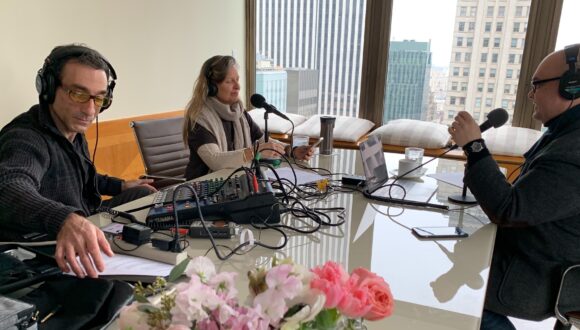Episode 37: Optimizing the Modern Revenue Tech Stack
Research from Sales Enablement PRO found that teams with sales enablement tools are 8 times more likely to have highly engaged reps. So what role does enablement play in the modern revenue tech stack?
Shawnna Sumaoang: Hi and welcome to the Win Win Podcast. I’m your host, Shawnna Sumaoang. Join us as we dive into changing trends in the workplace and how to navigate them successfully. Here to discuss this topic is Frank Kenney, the director of industry solutions at Cleo. Thanks for joining, Frank! I’d love for you to tell us about yourself, your background, and your role.
Frank Kenney: Thank you. My name is Frank Kenney. I look after industry solutions here at Cleo. I also do a lot of work in the sales enablement role and they’re intertwined. The best salespeople have a very close relationship with the customers and the business of the customers that they serve. If you’re going to sell someone something, you probably should have a good idea of how they make money and how your product is going to help them make money. It’s kind of a no-brainer shortcut to everything from access to the power to access to the purse. It’s just the best way to be. I play double duty.
I have been at Cleo for just six years. We’ll be headed to the seventh year starting in 2024, so just about six and a half years. I’ve been in the industry for the last 25, 30 years and I got my start at Gartner and was there for over a decade. When you’re working as an analyst or any type of academia or anything you tend to sit in an ivory tower and you give people advice on how to do things. It’s always great when you get the opportunity to go out and do things. I am really excited to be here and thanks for the opportunity to talk about Highspot.
SS: We’re excited to have you here as well, Frank. You gave us a little bit of background on your role, but as an owner of industry solutions across your organization, I’m sure you have a wide range of visibility into the overall tech stack. In your opinion, why is efficiency in the tech stack so important?
FK: One of the challenges in any sales or go-to-market organization is that the company wants to have a certain amount of consistency and predictability. The best companies can predict growth, can predict sales, can predict renewals, can predict all of those things that come directly from sales. As any organization or any go-to-market organization, you tend to put in a lot of processes to put up the guardrails so that you can have predictability. The tech stack really just supports those processes.
Now the danger is if you rely too much on the tech stack and you rely too much on the processes, then you lose the humanistic part of it. Kind of like what happened when music lost the analog world and music lost mistakes and we started getting very exact. It kind of just lost a lot of body. It lost a lot of soul. You never really want that to happen.
What’s interesting is it’s not just having great technology, it’s having great technology that can work together. When you do that, you allow your go-to-market organization, whether it’s your account executives, your guys on the front lines like SDRs, the guys that are in the middle, customer success, all of those guys It really allows them to have humanity and do things in a very personal and a very individualistic type of way and the technology kind of just sits there and helps them out with that. It’s not just having great technology, it’s not even having just a great technology stack. It’s having technology that can work together and be consistent in helping you achieve your outcomes.
SS: I love that. One of the outcomes that is really critical to a lot of organizations, especially right now, seems to be sales productivity. How does efficiency in the tech stack help you drive overall sales productivity?
FK: Time is the biggest enemy of any sales process. We live in a world where we have very realistic deadlines and generally, it’s the end of a quarter or the end of a cycle. It could be the end of the month. It could be the end of a quarter. It could be the end of the year. It could be everything in between. Those are all time-based variables. The most precious thing that a salesperson, for instance, would have is their time.
Again, a very efficient tech stack is going to find the opportunity to give that account executive as much of their time back in what they do so that that time can be used more effectively. That’s why productivity is so important because up until now we’ve thrown people at the problem of sales. Do you want to scale? Then just hire more salespeople. If you want to scale in a way that protects things like EBITDA or things like COGS if you want to scale in a very efficient way, then you’re going to bring in a support system for your sales operations to double your capacity, but not necessarily double your sales team. That’s really where the technology and productivity is really going to come from.
SS: I couldn’t agree more. Now, when building out your tech stack, what role does an enablement platform play in your overall strategy for solutions?
FK: One of the things to understand and a big mistake that a lot of companies tend to make is that enablement is a one-time thing. It really isn’t. Every sales enablement professional will find themselves constantly coaching, constantly enabling in terms of, as I said earlier, being able to bring your team new insights into what’s happening in an industry so that they can shift their focus. Well, that doesn’t scale well if you have one or two enablement guys. You’re going to look at technology or an enablement platform to help you with that.
I can have a conversation with five or six people a day or I can have 30 that consume a video with a short assessment at the end to make sure that they’ve picked up the points or a text box to make sure that they’re able to read it back to you or a video system where they can pitch something back to you to make sure that they have it right and then let a team of sales managers go in and take a look at that. That’s incredibly powerful. That to me, it’s not just the new person into a company, you’re going to fire hose them with a ton of material and you could spread it out.
Sometimes you have to do that, but the real gem in enablement is that continual enablement is continually helping people get better and fine-tune and course correct all the way until you land that deal. That’s really what a platform is going to do and a platform is going to allow you to do that at scale and allow you to be incredibly efficient with it.
SS: I love how you think about that holistically. What is the value from your perspective of having a unified enablement platform to help you bring your enablement strategy to life?
FK: Great question and the reason that I say that is one of the things from a sales enablement perspective that you never want to get into is you don’t want to get into this idea that you need X amount of people to succeed or X amount of people to fail, to know that you’re doing it, to know that you’re testing and all of those things. I want my sales guys to use every tool that they have possible. What that means is if I am creating a training module in Highspot, I want all of the materials that my team has reviewed to be available in the content part of Highspot.
If I’m just testing them on information that they’ll never, ever, ever use again, well, that’s not really helpful. What’s really helpful is giving them that material from a content perspective that they can use in a sales cycle or even better being able to take information from a sales cycle and rapidly update a training module because things change. It really speaks having an integrated unified platform really starts to speak to the agility that you need to have in any sales or go-to-market organization.
That includes the whole backend, being able to look at what folks are doing and run analysis, and being able to export that data to get insights or being able to integrate with other parts of an enablement stack to really understand the correlation between items that a rep is looking at training that a rep has done and how many times a phrase may be used on a call. That’s really the value of that integrated stack and that starts with an integrated enablement platform.
SS: I love that. To take a couple of steps back, before Highspot, what were some challenges that you were experiencing when it came to organizational operations and efficiency? How have you leveraged Highspot to help overcome these challenges?
FK: What’s interesting about Cleo’s Highspot story is that it really takes shape in this idea that we organically grew from OneDrive to SharePoint and we started to branch out to things like Google Drive and it just started to become a mess. When you start to add Slack, there are a hundred different ways that we are sharing information, like email and even text messaging and those types of things. Very quickly it was, hey Frank, you created a piece of content that was great and I think you did it two or three months ago. It was that slide with the three dots and whatever, but can you find that and send that over to this rep? They’re on a deal that they really needed.
Then what would happen would be a massive amount of updating and then a massive amount of changing templates and doing all the rest of that stuff. That’s the world that you grow out of when you’re doing content creation in PowerPoint and then you’re saving it to one drive and then you’re sharing it using SharePoint and then people are finding it and searching it. It’s just not efficient for version control and it’s also not efficient because it really promotes reps to save it to their desktop where I don’t have control of that content. Now, if a logo changes or styles change, then that doesn’t work.
Shawnna, I’ll give you a perfect example. Every year we have our revenue kickoff, which is what most companies do and they bring their sales team together. We did well last year, this is how we’re going to do well this year. You end up with so much good content only to kind of cringe when it’s May and you’re on a Zoom call with a potential customer or potential prospect, and you’re on the phone with that account executive and he pulls up a slide and it has all of your theme collateral from your sales kickoff. The sales theme kickoff was Indiana Jones, so you’re sitting here saying, oh my goodness, why is this in the Indiana Jones template and we’re talking to a trucking company? It’s that simple, but those moments absolutely count.
We lived in that world, and the best way for us to convince the business to make this type of investment is to say, aren’t you sick and tired of everyone asking you for slides, or everybody asking you, hey, can you update this? Or everyone asking you, hey, do you remember this white paper that was written and where can I find it? It was very easy to make an initial investment in Highspot. Once you’ve got everybody onto the platform and utilizing the platform well, it becomes very easy as a company grows to start to think about certification and assessments. It’s not, let me go find this other platform and maybe it’ll integrate, it’s exactly what I was saying, where you can reuse. That’s where it starts to just grow and it starts to become part of the culture.
That’s the Cleo Highspot story and that’s where we were before. Of course, we are conducting all of our training, whether it’s new products or new sales techniques or we’re going to be doing a bunch of new hire stuff. That’s really how you grow in your maturity with this type of platform.
SS: I definitely want to drill in and learn a little bit more about how you guys start to leverage training and coaching, but you did mention a really critical factor, which was the usage that you’ve been able to drive of Highspot within your organization. Over the last year, I think you’ve driven nearly 82% of recurring usage within Highspot. What are your best practices for driving the adoption of the platform throughout your organization?
FK: Interestingly enough, if I had to tell a new Highspot user, I would tell them to download the Slack plugin. The reason is, if you talk to enablement professionals that have any type of internal communications mechanism, like Slack or Teams or whatever the case is, that’s where all your requests are coming from. So two things. I jumped into Slack which is connected to Highspot and someone asked me for something. I can easily find it and I find it via Slack and then I just press a button and send it to them. Salespeople are hardwired, so sometimes it takes a lot to re-hardwire them. What I’ve found is after three or four times of doing that, they just say, you know, he’s not answering me as fast as I need him to answer. Let me just go and do a search through this thing.
Again, as a sales enablement professional, what I would say is you only have to work until they win their first deal using this platform and using content from this platform, because once they win that deal, then it becomes part of their process and their superstition. I couldn’t take Highspot away right now. They would be like oh my god, you know what you’re doing in my process, Frank, what are you doing? That’s what they would do. That’s the trick is to get them to believe that it’s critical to their success and successes, getting that ACV, getting that deal, successes, going to the winner’s circle, going to club successes, their face on slides at the end of a quarter or when you’re doing a quarter wrap up.
Every salesperson wants those things. It’s the accelerators on their salary. It’s really just nailing and multiplying their quota. You do that, you not only get that one sales guy, you get the three other sales guys that say oh yeah, we need to do what he’s doing. That’s how we got to that heavy amount of compliance. I think we’re actually driving even higher right now.
SS: Amazing benefits for the sales reps that are using the platform. What would you say has been the effect on the sales cycle since adopting Highspot?
FK: What’s interesting is we are a company that primarily works in the supply chain, and you can go to a Walmart or Target, or Dollar General, you can see the impact of pricing on the food that you buy or the things that you buy. Our business shifts, and sometimes people are buying quickly, and sometimes deal cycles spread out. What I can say is that in a business or with a metric like days to close or days to close won or your sales cycle, that metric is so inclusive of so many different influences. Having one stable piece of data that says this content has gone out this way, we are tracking this many pitches, we are tracking this much consumption. Having that stable data allows you to work on other things like do I need to change this part of the pitch? Do I need to do that?
One of the things that we’ve seen is, and I think this is important, Shawnna, it’s not about how long your sales cycle is or how short your sales cycle is, it’s about if I look across my team, is that consistent across my team? If it’s consistent across my team, I know that I have folks that are pretty much in lockstep, even though they’re doing some individual things, I have people that are lockstep, but that also means that if I can shave something down by five days, it’s going to impact the entire team. It really takes that unknown out of that equation, depending on how big the overall annual contract value is or life booking is or however you look at your sales. Depending on the complexity, you may have some cycles that are 100 days, you may have some cycles that are 300 days, and you may have some cycles that are 40. Being able to predict it is a key part of the business.
That’s what we’ve been able to achieve with Highspot. One of those things where I know that if I look at a sales cycle of 70 days, I’m going to be somewhere really close to that. That really just tells me I can impact change via Highspot, or I can impact change via some other type of coaching feedback, but I can do it consistently. I think that that’s a better way of thinking about the impact of highspot on the overall pipeline or overall sales close to closed won.
SS: I love the way that you guys think about that. Now, there’s been a couple of other areas of success within the platform that you have seen. You’ve seen an increase in responses from prospects through the pitching capabilities. How do you use Highspot to improve buyer engagement?
FK: Highspot was a game changer in this case for us because like any company, when you send out a proposal with your pricing and everything else like that, as a salesperson, you want feedback. What did you think, and is it too high? Or is it what you expected? Or should we go forward, or is this a deal-stopper? The first part starts with, did you get my email? If you can calm a sales organization down at that point, you can keep them from being in their own way.
I now require all of our pricing, implementation, and statements of work and those types of things be sent out via Highspot as a pitch because the account executive will get the feedback that they need, that validation, okay, they got it, they read it. Now, they can go sit back and just watch the metrics from the engagement tab in Highspot. They can just watch the interaction, and the cool part about just being able to watch that interaction, almost in real-time, is that it keeps them from being a nuisance. It keeps them from calling, what do you think? It gives people room to become more objective and to make better decisions. It stopped our salespeople from being pests at the end of the sales cycle and ruining a sales cycle, so absolutely recommended best practice.
Of course, again, when you see that you don’t have to reach out to someone every hour of every day or every day. When you see that they’re still interacting with the content and know that that’s being logged somewhere in Salesforce and being correlated, it allows your sales team to have time to work on another opportunity. You and I both know all the opportunities seem to come in the last month of the quarter, so there’s always plenty to do. It’s a time saver, it’s an anxiety saver. You no longer wonder if they are ghosting you or know if you are alive. It’s classic, she’s reading my text. Okay, so at least she’s reading them. I’m not blocked. It’s that type of comfort that just helps a salesperson get through the day and get to the day in an objective, clear, rational manner.
SS: I’m glad that it gives your reps that level of visibility into how buyers are engaging with them. Now, you talked about this a little bit earlier and I hope we have enough time for at least two more questions because I definitely want to ask you guys about Highspot’s Training and Coaching. Now you’ve started to use these capabilities to help improve the efficiency for sellers on how they consume training and how teams also create training. What are some of the ways you’ve leveraged Highspot to deliver efficient training?
FK: The efficiency on how I look at efficiency is how fast can I get a new rep up and running and contributing to the overall goal of the organization. Again, that’s what I’m here to do. I like to look at it as how fast can I help them make money, and that’s the way that I explain it. When a new rep comes in and does all the onboarding and you give them access to the platform, and you want them to go through some modules, and you do some stuff face to face, and you do some stuff over Zoom, but, they’re going through modules and assessments and they can go back to it, you bring people up to speed faster.
Even more importantly than getting people up to speed with processes and all of that minutiae, the science of it all, you really start to bring them into your culture. Highspot, for us, not only enforces the science of how we do things and how we love to do things at a higher level than other sales organizations, it enforces our culture and our culture of we want our sales guys to make money and make their lives better and make their families lives better. We will give you tools and techniques to be able to do that. So Highspot, besides the training and the coaching modules, is a place where they can learn the science of it. Especially newer reps or more junior reps that are coming through the ranks, when they see it and they understand the investment and the reference that it will become a part of their lives, it becomes a cultural thing. It becomes, wow, this is what Cleo is willing to do for me, and it’s that little difference is what our customers and our prospects end up seeing because it’s a sales guy that wants it more, it’s a sales guy that believes that it’s not just technology. It’s a partnership that you’re buying into.
That partnership is composed of people. Every salesperson and every employee that works for Cleo has entrusted Cleo with their well-being and their family’s well-being. Highspot training specifically is just another validation of an investment and a commitment that we make to our employees and our customers by extension. It really is a much bigger deal than just using it for testing to get people up to speed fast. It really is a reflection and a helper in buying into a culture.
SS: Fantastic. Frank, last question for you. To close, what is your advice on how to maximize the ROI of enablement through tech stack optimization?
FK: I would say, interestingly, out of the box is really helpful for you to get buy-in from your organization. I didn’t have to do anything to get buy-in from my organization, other than what my Highspot rep and my Highspot solutions architect recommended. That helped me get the buy-in from the organization, but really starting to get that return on investment was really when I started going in and making my own reports. I started going in and pulling out data about how things are being used and which things aren’t being used to be able to go back to a marketing team to say, hey, the reason why this particular webinar wasn’t well attended is that we didn’t do enough internal promotion to get people to come. Then, I can turn around and do that and find so much more engagement from a sales organization. Well, that gives you an ROI on all of your webinars or your in-person conferences and all of those types of things.
Being able to really keep salespeople from hurting themselves and asking questions that we probably should have answers to using the engagement and the pitching function is an absolute plus. Don’t look at your ROI by saying how much money Highspot saved me. Look at it from the perspective of how much money did I make or did I save in this particular marketing activity or this particular product launch activity or this particular COGS realignment? How much money did I save I was able to rally my entire sales organization, lickety split in a matter of hours, and get everybody talking about the same thing.
Recently, I just went into our pitch templates, which is the template that our users send out information. I went in and I just put a link to an upcoming webinar, and because our users are pitching so much, that link is going out in a way that it just would not have been seen by our marketing. It’s being seen by the people who need to see it, and when you start to look at the benefits, the ROI, and all the other metrics, that’s where you can measure and you see the best improvement. My recommendation would be, don’t just look at the platform. Look at all of the benefits that the peripheral functions in an organization benefit. That’s where you’re going to start to see your best ROI.
SS: I love that. Frank, thank you so much for joining us today.
FK: My pleasure. Thank you for having me.
SS: Thank you for listening to this episode of the Win Win podcast. Be sure to tune in next time for more insights on how you can maximize enablement success with Highspot.





